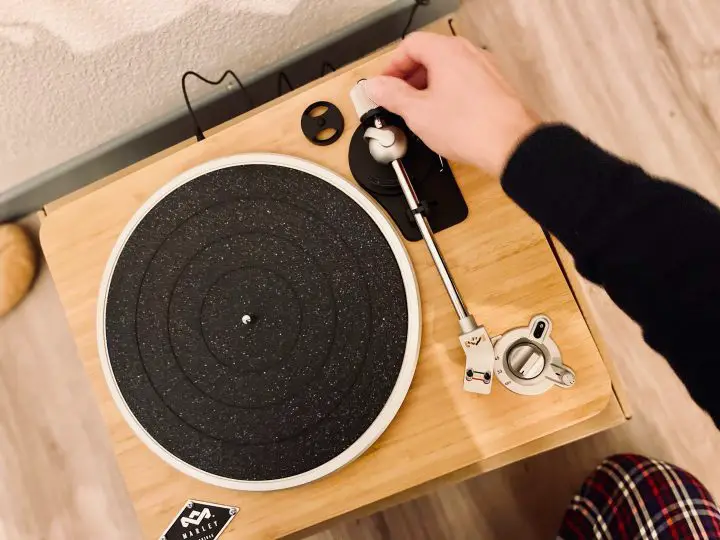Just got your first turntable and got to wondering what the heck this furry thing is on the platter? What are slipmats? Why are they so important? What different kinds are there? And do you need one?
The “furry thing” on the platter you’re referring to is likely a slipmat, which is an essential component of turntable setups, particularly for DJs and vinyl enthusiasts. Let’s break down what slipmats are, their importance, and the different kinds available.
Choosing the right slipmat depends on your primary use case.
If you’re into DJing, a felt slipmat might be your best bet.
For audiophiles focused on sound quality, cork or rubber might be more appealing. Experimenting with different types can help you find the perfect match for your turntable and listening preferences.
All this and more today as we explore some important questions around slipmats, including their origins and the different contexts within which they are still relevant today.
Table of Contents
- What are Record Slipmats?
- Why are Slipmats Important?
- Different Kinds of Slipmats
- Slipmat vs Platter Mat vs Felt Mat, etc
- Do I Need a Record Slip Mat?
- Adding One to Your Turntable
- Why Cork?
- The History
- Turntable Mats Today: Hi-Fi
- Final Tones
- FAQs What Are Slipmats?

What are Record Slipmats?
Slipmats are circular mats placed on the turntable’s platter, beneath the vinyl record. Unlike the rubber mat that might come standard with some turntables, slipmats are usually made from felt, cork, rubber, or a combination of materials. They serve several purposes, from protecting your records to affecting playback.
Why are Slipmats Important?
- Protecting Vinyl Records: Slipmats provide a soft, smooth surface that protects your records from scratches, dust, and static that could be caused by the turntable’s platter. This protection is vital for maintaining the quality of your vinyl over time.
- Improving Sound Quality: The material and thickness of a slipmat can influence vibration dampening and static reduction, which in turn can affect sound quality. Certain materials may provide better isolation from motor and environmental vibrations, leading to a cleaner sound.
- Facilitating DJ Techniques: For DJs, slipmats are crucial for techniques like scratching and beatmatching. A good slipmat allows the record to slip (hence the name) freely over the platter without moving the platter itself. This enables precise control over the record’s motion for scratching and cueing.
Different Kinds of Slipmats
Felt Slipmats
These are the most common type, offering a good balance between grip and slip. They’re excellent for general use and DJing, allowing for easy manipulation of the record.
Cork Slipmats
Cork slipmats are known for their ability to dampen vibrations and reduce static, potentially improving sound quality. They provide a firmer grip than felt, which some vinyl enthusiasts prefer for listening purposes.
Rubber Slipmats
Rubber mats, often thicker and heavier, provide excellent vibration isolation and stability. They might not be the best for DJing due to their grip but are great for audiophiles looking to maximize sound quality.
Hybrid Slipmats
These slipmats combine materials, like felt with a cork or rubber backing, to offer the benefits of both. They aim to provide the perfect balance between control for DJing and audio fidelity for listening.
Slipmat vs Platter Mat vs Felt Mat, etc
The variety of mats used to adorn the turntable platter will depend on the manufacturer’s intentions. This can almost always be changed very easily by the user, though in terms of that which it is shipped out with, this is the case.
More and more often, turntable manufacturers are turning to materials like acrylic for their mats. This material, in particular, has been shown to be very effective in combatting those pesky extraneous vibrations that can so often mar a listening experience.
That being said, the most popular materials from which mats are constructed are usually rubber and cork. A great place to experiment and have a deeper look at a lot of these materials is Turntable Lab, which offers such services free of charge. If you want to learn about cork mats and what precisely a cork mat can bring to the table, then get on down.
Slip mats are, more often than not, simply bought for decorative purposes. With the culture around audiophilia being centered around precisely this mood of aesthetic value, it is no wonder that such an understanding has been cultivated between producer and consumer.
There are some pretty fun ones, to be fair, such as:
Do I Need a Record Slip Mat?
Slipmats are essential for a range of vinyl record players, but their necessity can vary depending on the user’s activities and priorities. Here’s a breakdown of who might need a slipmat for vinyl and why:
DJs
- Primary Users: DJs are the primary users of slipmats. They need slipmats to perform techniques such as scratching and beatmatching. Slipmats allow the record to move independently of the platter, enabling DJs to manipulate the vinyl for precise control over the music.
- Type Preferred: Felt slipmats are popular among DJs because they offer the right balance of slip and grip for scratching and mixing.
Vinyl Enthusiasts and Audiophiles
- Sound Quality: Vinyl enthusiasts and audiophiles who prioritize sound quality might use slipmats to reduce static and vibration. A slipmat can offer a cleaner playback by minimizing unwanted noise.
- Type Preferred: Cork or rubber slipmats are favored in this group for their vibration-damping qualities and static reduction, potentially enhancing the listening experience.
Casual Listeners
- Protection and Aesthetics: Casual listeners might use slipmats to protect their records and turntable platter from dust and scratches. Slipmats also offer a way to personalize the look of a turntable with various designs and materials.
- Type Preferred: The choice of slipmat material can vary based on personal preference, but felt slipmats are a common and versatile option.
Turntable Owners Concerned with Maintenance
- Preservation: Owners looking to maintain their turntable and records in top condition may use slipmats to help protect both the vinyl and the platter. Slipmats can prevent direct contact that might cause wear over time.
- Type Preferred: Any type of slipmat that fits the owner’s aesthetic preference and protection needs, with a slight lean towards materials that offer good protection and static reduction.
Whether you’re a DJ needing precise control for performance, an audiophile seeking the best sound quality, a casual listener wanting to protect your equipment, or simply looking to add a personal touch to your turntable, there’s a slipmat designed to meet your needs. The choice of slipmat can significantly impact your vinyl listening experience, both in terms of functionality and enjoyment.
Adding One to Your Turntable
One of the main things to remember when buying your own mat and installing it yourself is to check what material it is made from and adjust accordingly.
If it is made from rubber or cork, then it is almost certainly going to be thicker than the slipmat that comes installed as standard. Though a relatively insubstantial thickness elsewhere, this will make all the difference on a turntable.
So, if the turntable mat you are intending to use is made from either of these materials, you will need to adjust the Vertical Tracking Angle, a measure of how the tracking will work on a turntable. For DJs, this will be set to 0 to allow them to move freely over the disc to find the next moment in a song.
This will need to be set specifically for the thickness of the mat you are using, advice on which you can find here. A tell-tale sign that you have not installed it correctly is if the sound is notably duller or brighter than it was with the old slipmat on.
Why Cork?
Cork mats, though perhaps not the most popular choice on the market today, still have a relatively high rate of purchase due to a few of their inherent characteristics. These are usually measured in direct contrast to rubber mats which can have a dampening effect on the overall playback. Cork mats, instead, are judged to have a rather natural and organic tonal palette.
This is all informed by the fact that many audiophiles believe that the slipmat that is used can have a direct impact on the overall sound of the vinyl records that comes out of the speakers.
While some audiophiles believe that this is dependent on the resolution of the system in question, others simply believe this is something inherent in all stereo systems that can play records.
That a slipmat can have such an immediate impact on the sounds coming out of a set of speakers might seem ludicrous at first. However, when you look at the fact that sound is little more than structured vibrations, it begins to make a little more sense.
These vibrations are being carried through the air and feeding themselves through objects. If the slipmat is one of the objects that the sound vibrations are being ushered through, then it stands to reason that the material from which it is constructed will have an impact on the overall sound produced.
The History
We better address why the slip mat was ever used in the first place, lest we lose sight of its original purpose and the intent behind it.
The true reason the turntable platter mat originally came into use was for DJs. Yes, back in the days when a DJ was crafting out an atmosphere from just two turntables, the turntable mat was a vital tool to ensuring that this process was as lubricated as possible.
So, while the turntable platter below continued to spin, the felt mat below was soft enough to allow the disc above to move freely over its surface.
This was vital in a time when there were no digital means with which to track certain parts of a track. If a DJ wanted to go into a song at a certain part, they had to physically find that part on the disc and cue it up. Just as turntable pitch control helps a DJ, a slipmat does too.
This is easier said than done, of course, hence why turntable mats were vital in allowing a DJ to cue up to a certain part of a track without needing to stop the platter in its tracks (if you will pardon the pun). The best DJ turntables will feature a slipmat.

Some analog DJs actually prefer to use a leather mat or even rubber mats, though the real weapon of choice is a felt slipmat, as this material arguably provides the most freedom of movement. A rubber mat is all well and good if you want to keep your record in place and not slip all over when it is spinning, it will not provide nearly as much dexterity of movement in a DJing context.
Now, if you do have a felt mat, do not just go and start scratching all over the place with it. Turntables need to be properly calibrated to allow for this sort of thing.
Turntable Mats Today: Hi-Fi
The turntable mat has taken on a completely different utility for the purposes of audiophilia. This has been especially exacerbated by the second vinyl boom, something that has only encouraged this detached and nostalgic audiophilia even more.
In this context, the mat plays a part in a much wider scheme. Within and upon a turntable, the tonearm, platter, headshell, cartridge, and platter mat must all work together as part of this allegiance toward high-quality audio playback to achieve maximum fidelity.
In this context, felt mats are infamous for not working as well. Though they are such a standard option when it comes to mixing discs as a DJ, they have one big downfall that means they are less highly regarded in the context of audiophilia.
Indeed, for all its usefulness and ubiquity in a DJing context, it bears very few anti-static properties, something that is far more important in a home hi-fi setup. Such static can cause a serious issue to sound quality in an audiophile home setup – anyone who has heard their records crackle and pop knows that.
Yes, some of those crackles and pops that you sometimes hear when playing records and that have come to emblemize the audiophile experience might be caused by static and not dirt or dust. Hence why some turntables are fitted with acrylic platter mats, known to inherently absorb such static.
Thus, a turntable slipmat and a DJ slip mat are rather different things in some ways.
Final Tones
So, there you have it! Hopefully, you are now feeling a little more clued into what slipmats are. Who knows, perhaps you are even looking at making an investment of your own to maximize your listening experience or to mix discs afresh!
FAQs What Are Slipmats?
What is the point of a slipmat?
Depending on the context, a slipmat can have different uses. The original use for slipmats developed in DJ circles in the early days of turntablism. During this period, the felt slipmat was used to adorn a turntable so that a DJ could adjust the position of the stylus on the record without having to stop the platter fully. The slipmat has since taken on a different role in home audiophile environments, where this kind of flashy and speedy mixing of songs together is not quite as relevant. Here, the slipmat is instead used as a method through which extraneous vibrations and static are absorbed so that they can no longer mar a listening experience to the same degree.
Do I need a slipmat for my record player?
Not necessarily, no. There are certain things that a slipmat is good for, and that might enhance your listening experience and user experience considerably, though. In a DJ context, a slipmat is an indispensable tool that allows a DJ to cue up a certain part of a song, going back and forth with the record, without needing to stop the entire platter. Likewise, in a home listening environment, a slipmat can be very useful in absorbing extraneous vibrations and stray static that might otherwise ruin a sanctimonious listening experience.
Is a rubber slipmat good?
For certain things, yes, though it certainly has drawbacks too. For the absorption of vibrations, a rubber slipmat is incredibly well-adapted. However, this same quality that makes it adept at absorbing vibrations also means that its overall tonal character can be quite dull or muffled. Indeed, many audiophiles now believe that the material from which a slipmat is constructed has a direct bearing on the quality of the overall sound. In this instance, a rubber slipmat is deemed to be far duller than, say, one made from cork.
How does a record slip mat work?
A slipmat is arguably one of the most simple parts of a turntable, hence why they are sometimes not even included. This is usually one piece of material cut into a circular shape that best fits the turntable in question, typically fashioned from rubber, felt, or cork. Which material you choose depends on what exactly you intend to use the slipmat for. For the purposes of DJing, there are none better suited to the job than a felt slipmat. For home listening use and absorption of stray vibrations and static, then the others are more likely to be of use.
What is the best material for a slip mat?
This will largely depend on what you intend to use the turntable for. If you are a budding DJ who will be using it to spin and mix discs together, then you will likely want to use a felt slipmat. These are specially designed so that a disc can float freely from the spinning platter, so that you may mix properly without having to stop the platter entirely. If, instead, you are looking for a slipmat for home listening, then something made of cork or rubber will perhaps be better suited to the job.









